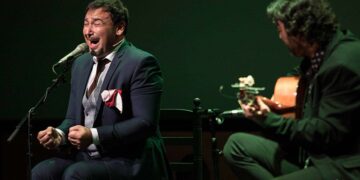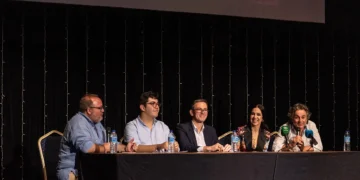|
“Dos voces para un baile” |
|
SPECIAL BIENAL DE FLAMENCO DE SEVILLA 2008 Text: Estela Zatania Dance: Javier Barón. Cante: José Valencia, Miguel Ortega. Guitar: Javier Patino, Ricardo Rivera. Palmas/dance: Antonio Molina “El Choro”, Juan Diego. Long before Javier Barón was awarded the Giraldillo of dance at the Bienal twenty years ago, I’d already discovered him – those moments of personal satisfaction we all have, when we see a young unknown and think “this person is special”, or if it’s someone older, “why isn’t this person a major star?” Now, within the framework of the same Bienal that conceded him that honor, Barón arrives with his work “Dos Voces Para un Baile”, and I find myself with both thoughts: Javier Barón is one of the finest male flamenco dancers today, but he doesn’t quite reach that state all performers long for, the status of “major star”. Perhaps it’s the lack of extravagance in everything he does. His style is restrained, sincere, essential, straightforward, with a clean line and an approach that doesn’t make demands on the spectator, but rather invites him or her to come along for the sheer pleasure of it. For reasons unrelated to dance, “Dos Voces Para un Baile” is not Barón’s best work. The opening, that has the dancer sitting motionless at one side of the stage, wrapped in a cloud of smoke, listening to his own off-stage voice remembering the beginnings of his career, prepares you for a biographical journey that never materializes. After a long time, the off-stage narrative is again heard, but by then the thread has been broken, and the show has turned into a traditional dance recital without script. Efforts are made to have the numbers flow seamlessly from one to another, but some transitions are disorganized. The depressing darkness so fashionable these days (I’ve begun to notice reviews from abroad refer to the “customary” lack of lighting in flamenco shows), subtracts energy. Two dancers, Antonio Molina “El Choro” and Juan Diego, serve as palmeros, a novel idea that doesn’t quite work; when they insert their well-rehearsed dance tidbits, you don’t know whether they’re ambitious palmeros or lazy dancers. Another experiment showed more potential. Taking advantage of the binary compás that lurks beneath the surface of bulerías and allows free transit between tangos and bulerías, that is precisely what they did; it comes off mostly as a prank, but there are unexplored possibilities. Between dances, guitar solos and cantes, an admirable assortment of forms are represented: farruca, taranto, levantica, fandango del Toronjo, trilla, abandolao, siguiriya, malagueña, guajira, tangos del Piyayo and Triana… And the magnificent soleá of Javier whose hometown of Alcalá has played such an important role in the history of this form, ending with first-class stylized bulerías, wonderful. At the end, the applause was more or less complacent when group members bowed, contrasting with a tremendous tsunami of shouts of approval and effusive applause for Javier Barón – the sure sign of a discreet show by an undeniably major star.
|
Descubre más desde Revista DeFlamenco.com
Suscríbete y recibe las últimas entradas en tu correo electrónico.


 XV BIENAL DE FLAMENCO DE SEVILLA
XV BIENAL DE FLAMENCO DE SEVILLA























